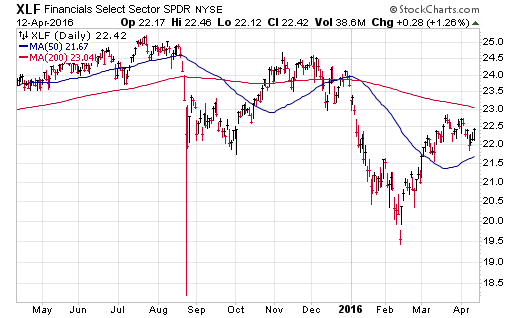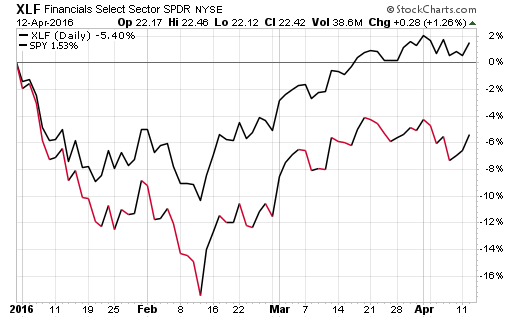The financial sector has been one of the notable disappointments in the market over the last several years. The hype was that many of these companies would thrive as the United States exits years of zero interest rate policy. However, several months after the first rate hike, we have yet to see a trend change take shape. In fact, it looks like investors in financial stocks are still anticipating that the worst is yet to come.
Exposure to energy debt has been a primary concern for top banking institutions as credit conditions experience volatile whipsaws. Furthermore, the dismal sentiment towards international financial institutions like Deutsche Bank AG (DE:DBKGn) NA O.N. (NYSE:DB) and Credit Suisse (SIX:CSGN) Group AG (NYSE:CS) is likely creating a halo effect for their domestic counterparts.
The most widely followed index of mega-cap financial stocks is the Financial Select Sector SPDR ETF (NYSE:XLF). This exchange-traded fund tracks a market cap weighted index of 92 companies in the S&P 500 engaged in banking, real estate, insurance, and capital markets.
Top holdings in XLF include: Berkshire Hathaway B (NYSE:BRKb), Wells Fargo & Co (NYSE:WFC), JP Morgan Chase (NYSE:JPM), Bank of America (NYSE:BAC), Citigroup Inc (NYSE:C). Those stocks represent over one-third of the $15.5 billion in total assets. With the exception of Berkshire, all four of the top banks in XLF are due to report earnings this week.
These earnings results could spark a major market catalyst during the month of April. Financials make up 15.49% of the SPDR S&P 500 ETF (NYSE:SPY) as the second largest sector in the broad market index behind technology companies.
The good news is that quarterly consensus earnings estimates for these major banks have been downgraded relative to last year. That makes the bar much easier to clear. However, their recent price action suggests some measure of trepidation persists.
The chart below shows how XLF was one of the leaders on the downside in the January and February swoon. However, despite a broad rally in the majority of risk assets (including credit), we have yet to see significant improvement in this ETF from the lows.

Additionally, XLF is still far underperforming the broad-based SPY on a year-to-date basis and well below its 2016 break-even point. This large-cap financial index is still the worst performing major sector on a relative and absolute basis this year.

The key to a successful outcome with sector investing is to identify the characteristics that you find most attractive and gravitate towards those factors. If you are a value investor or are drawn to the notion of a comeback story, then you may be considering dipping your toe in the financial sector as a potential opportunity. Conversely, those who seek to identify more consistently strong trends may shy away from the troubles that have plagued this group.
Either way, financial stocks are likely going to play a key role in the market narrative this year. Buckle up, because the fun is just getting started.
Disclosure: FMD Capital Management, its executives, and/or its clients may hold positions in the ETFs, mutual funds or any investment asset mentioned in this article. The commentary does not constitute individualized investment advice. The opinions offered herein are not personalized recommendations to buy, sell or hold securities.
